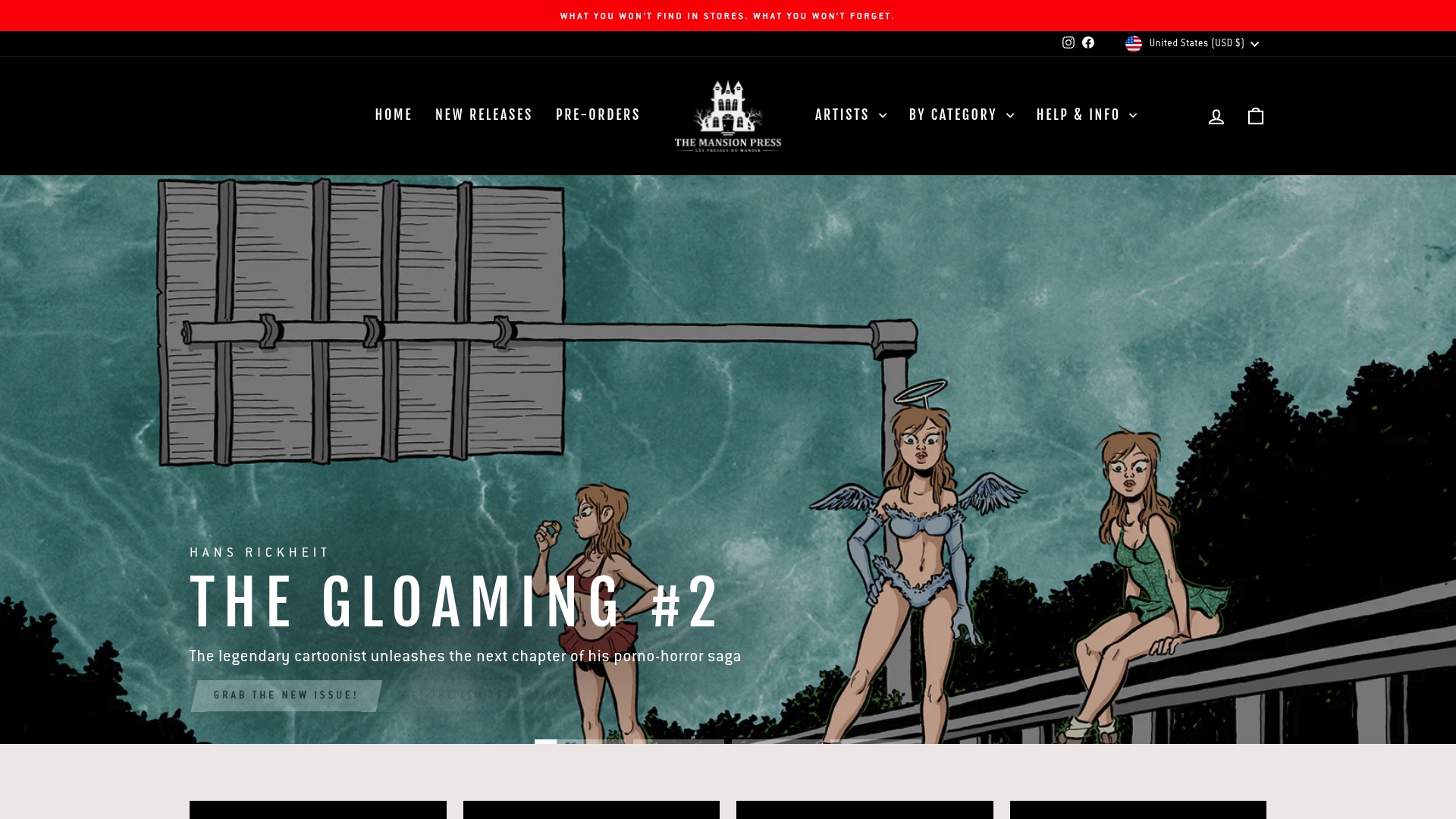7 Disturbing Comics List: Must-Reads for Fans
Disturbing comics are capturing more readers than ever, with visual stories that don’t just unsettle but spark real psychological debate. You might think comics are all bright colors and superheroes, but some of the most talked-about titles deal with trauma, taboo, and the darkest corners of the mind. In fact, studies show graphic narratives give a unique space for confronting sensitive topics without overwhelming readers. The real surprise is how these comics offer deep insights about society and ourselves—sometimes revealing more in a few panels than a whole novel ever could.
Table of Contents
- Understanding The Appeal Of Disturbing Comics
- Key Themes In Disturbing Comics
- Top 7 Disturbing Comics You Must Read
- Analyzing Art Styles In Disturbing Comics
- The Role Of Horror In Comic Storytelling
- How To Collect Disturbing Comics
- Future Trends In Disturbing Comics
Quick Summary
| Takeaway | Explanation |
|---|---|
| Disturbing comics explore complex human experiences. | They address themes like trauma and societal issues, pushing readers to think critically. |
| Visual storytelling creates emotional engagement. | Graphic narratives transform challenging topics into relatable art, making discomfort easier to confront. |
| Research enriches understanding of disturbing narratives. | Studies highlight emotional responses and psychological insights gained from comics, providing a deeper connection. |
| Collecting requires education and relationship building. | Serious collectors should learn about the medium and connect with experts for meaningful acquisitions. |
| Future trends focus on diverse voices and technology. | Emerging comics will incorporate interactivity and represent a wider range of cultural perspectives. |
1: Understanding the Appeal of Disturbing Comics
Comics have long been a powerful medium for exploring complex human experiences, and disturbing comics represent a unique genre that pushes artistic boundaries. These graphic narratives do more than shock readers they provide profound psychological insights into human nature, societal tensions, and personal trauma.
The psychological appeal of disturbing comics stems from their ability to transform uncomfortable narratives into visual storytelling. By presenting challenging themes through sequential art, these comics create a safe distance that allows readers to engage with difficult subjects without feeling overwhelmed. According to research from the Health Information and Libraries Journal, graphic narratives offer unique opportunities for exploring sensitive topics through a controlled artistic medium.
Readers are drawn to disturbing comics for several compelling reasons:
- Emotional catharsis: Experiencing intense narratives through art can help process complex feelings
- Psychological exploration: Graphic representations allow deeper examination of human experiences
- Artistic expression: Breaking traditional storytelling boundaries reveals innovative narrative techniques
Moreover, disturbing comics challenge readers intellectual and emotional boundaries. They force audiences to confront uncomfortable truths about human psychology, social structures, and personal limitations. The visual nature of comics amplifies emotional impact, making these narratives more visceral and immediate than traditional written stories.
These graphic narratives are not merely about shock value. They represent a sophisticated art form that uses visual metaphors, complex character development, and nuanced storytelling to explore profound human experiences. By presenting challenging content through carefully crafted sequential art, disturbing comics transform potentially traumatic narratives into powerful artistic statements that resonate deeply with readers.
2: Key Themes in Disturbing Comics
Disturbing comics represent a profound artistic medium that transcends traditional storytelling by exploring complex psychological and social landscapes. These graphic narratives delve into themes that challenge readers perception of reality, morality, and human experience.
Psychological Trauma and Transformation emerges as a central theme in many disturbing comics. Artists use visual storytelling to map the intricate pathways of human suffering, exploring how individuals process and survive extreme emotional experiences. According to research from the National Institutes of Health, these narratives often serve as powerful metaphorical explorations of collective human anxieties.
Key thematic elements in disturbing comics frequently include:
- Social Marginalization: Exploring experiences of individuals existing outside mainstream societal structures
- Psychological Breakdown: Examining the fragile boundaries between sanity and mental disintegration
- Power Dynamics: Investigating complex relationships of control and vulnerability
Moreover, these comics frequently interrogate societal taboos and unspoken cultural tensions. They provide a visual language for discussing uncomfortable subjects like systemic oppression, individual trauma, and the darker aspects of human nature. By transforming abstract psychological experiences into visceral visual narratives, disturbing comics create a unique space for critical reflection.
The genre challenges readers by presenting complex moral landscapes where traditional narratives of good and evil dissolve. Characters are rarely presented as simplistic archetypes but instead emerge as nuanced, deeply flawed individuals navigating intricate emotional terrains. This approach demands active engagement from readers, encouraging them to confront their own preconceptions and emotional responses.
Ultimately, disturbing comics serve as a powerful artistic mechanism for exploring human complexity, challenging societal norms, and creating profound emotional experiences through visual storytelling.
3: Top 7 Disturbing Comics You Must Read
The world of graphic storytelling offers extraordinary narratives that challenge readers psychological boundaries. These seven comics represent pinnacle achievements in visual storytelling, pushing artistic boundaries while exploring profound human experiences.
According to University of Michigan’s research guide on horror comics, these graphic narratives represent transformative works that transcend traditional storytelling conventions. Each comic selected represents a unique exploration of human darkness, psychological complexity, and societal tensions.
Recommended disturbing comics for serious readers include:
- Maus by Art Spiegelman: A haunting Holocaust narrative depicting Jews as mice and Nazis as cats
- Watchmen by Alan Moore: A deconstruction of superhero mythology exploring moral ambiguity
- From Hell by Alan Moore: A graphic investigation into Jack the Ripper’s psychological landscape
Psychological Complexity and Artistic Innovation
These comics do more than shock. They represent intricate explorations of human nature, transforming traumatic experiences into powerful visual metaphors. Sandman by Neil Gaiman offers a philosophical journey through mythology and human consciousness. Hellblazer presents a gritty supernatural world where moral boundaries constantly shift.
Raw Emotional Landscapes
Comics like Johnny the Homicidal Maniac by Jhonen Vasquez and Black Hole by Charles Burns represent extreme psychological territories. They strip away societal pretenses, revealing raw human vulnerabilities and hidden psychological landscapes.
Each comic demands active reader engagement. They challenge traditional narrative structures, forcing audiences to confront uncomfortable truths about human nature, societal mechanisms, and individual psychological experiences. These are not mere entertainment pieces but profound artistic statements that leverage sequential art’s unique storytelling capabilities.
4: Analyzing Art Styles in Disturbing Comics
Art styles in disturbing comics represent complex visual languages that transcend traditional graphic storytelling. These artistic approaches transform narrative experiences through strategic visual manipulation, creating powerful psychological landscapes that challenge readers perceptions.
Research analyzing visual art complexity reveals that artistic styles operate on intricate scales of order and disorder. In disturbing comics, artists deliberately leverage these visual dynamics to evoke emotional responses and communicate profound psychological experiences.
Key visual techniques in disturbing comics include:
- Fractured Perspective: Disrupting traditional panel layouts to create psychological disorientation
- Monochromatic Palettes: Using limited color ranges to intensify emotional impact
- Expressionistic Distortion: Warping human figures to represent internal psychological states
Stylistic Approaches
Artists employ multiple strategies to communicate psychological tension. Hyperrealistic rendering can create unsettling details that force readers to confront uncomfortable truths. Alternatively, abstract and minimalist styles transform complex experiences into stark visual metaphors.
Technical Complexity
The most effective disturbing comics demonstrate remarkable technical sophistication. Line work becomes a language of psychological exploration. Shadows, negative spaces, and unconventional panel designs transform sequential art into profound emotional experiences. Artists like Dave McKean and Bill Sienkiewicz pioneered approaches that blur boundaries between illustration, painting, and graphic storytelling.
These visual strategies do more than illustrate stories. They create immersive experiences that challenge readers perceptual boundaries, transforming graphic narratives into powerful vehicles for exploring human complexity. By manipulating visual elements, artists in the disturbing comics genre generate visceral emotional responses that traditional storytelling cannot achieve.
5: The Role of Horror in Comic Storytelling
Horror in comic storytelling represents a sophisticated narrative technique that transforms fundamental human fears into powerful visual experiences. Far beyond simple shock value, horror comics create complex psychological landscapes that explore the deepest recesses of human vulnerability.
According to research exploring horror genre storytelling, horror provides a unique mechanism for confronting existential anxieties from a safe psychological distance. Comics leverage visual storytelling to amplify these experiences, creating immersive narratives that challenge readers perceptual boundaries.
Key psychological functions of horror in comics include:
- Emotional Catharsis: Providing controlled environments to process complex fears
- Social Commentary: Revealing underlying societal tensions through metaphorical narratives
- Psychological Exploration: Mapping internal emotional landscapes through external representations
Narrative Transformation
Horror comics transcend traditional genre limitations by using visual metaphors that communicate complex psychological states. Artists strategically deploy graphic imagery not merely to shock but to reveal deeper human experiences. Monsters become representations of internal struggles, supernatural events symbolize psychological transformations, and graphic violence serves as a language for exploring systemic traumas.
Psychological Mechanisms
The most compelling horror comics operate through subtle psychological manipulation. They create tension through anticipation, suggestion, and carefully constructed visual narratives. By disrupting readers expectations and challenging comfortable perceptions, these comics generate profound emotional responses that extend far beyond initial shock.
Ultimately, horror in comic storytelling represents a sophisticated artistic approach to exploring human complexity. It transforms fear from a destructive emotion into a powerful mechanism for understanding ourselves and our collective psychological landscapes.
6: How to Collect Disturbing Comics
Collecting disturbing comics requires a nuanced approach that combines artistic appreciation, historical understanding, and strategic acquisition. This specialized collecting process goes beyond simple purchasing and transforms into a sophisticated form of cultural preservation.
University of Michigan’s research guide on horror comics highlights the importance of understanding the broader context of graphic storytelling when building a meaningful collection. Serious collectors approach their passion with scholarly dedication and careful consideration.
Essential strategies for building a compelling disturbing comics collection include:
- Research Original Prints: Prioritize first editions and limited release publications
- Verify Authenticity: Develop relationships with reputable comic dealers and authentication experts
- Understand Preservation: Invest in archival storage materials to protect fragile comic editions
Collector’s Considerations
Buying disturbing comics involves more than financial investment. Collectors must develop deep knowledge about artistic movements, narrative techniques, and historical contexts. Condition matters significantly. Minor imperfections can dramatically impact a comic’s value, so careful examination becomes crucial.
Market Dynamics
The market for disturbing comics fluctuates based on artistic reputation, historical significance, and cultural relevance. Rare issues from groundbreaking artists like Alan Moore or Dave McKean can command substantial prices. Emerging collectors should track auction records, attend specialized comic conventions, and network with experienced collectors.
Successful collecting requires patience, expertise, and a genuine passion for graphic storytelling. Each acquired comic represents not just a purchase but a piece of artistic heritage, capturing complex psychological landscapes through visual narrative. Collectors become custodians of a unique artistic form, preserving powerful stories that challenge conventional storytelling boundaries.
7: Future Trends in Disturbing Comics
The landscape of disturbing comics is rapidly evolving, driven by technological innovations, shifting social dynamics, and emerging artistic perspectives. Contemporary creators are pushing boundaries beyond traditional narrative structures, transforming graphic storytelling into powerful societal commentary.
Stanford Humanities Center research indicates that comic books serve as critical cultural mirrors, reflecting and challenging societal narratives through innovative visual storytelling.
Emerging trends in disturbing comics include:
- Digital Interactivity: Incorporating multimedia and interactive storytelling experiences
- Global Perspectives: Amplifying voices from diverse cultural backgrounds
- Psychological Complexity: Deeper exploration of nuanced human experiences
Technological Integration
Digital platforms are revolutionizing how disturbing comics are created and consumed. Augmented reality, interactive narratives, and cross-platform storytelling are transforming traditional comic book experiences. Artists now have unprecedented tools to manipulate visual perspectives, create immersive experiences, and challenge reader perceptions.
Social Commentary
Future disturbing comics will likely continue serving as powerful mechanisms for social critique. By presenting challenging narratives through graphic storytelling, artists can address complex issues like systemic oppression, mental health, and collective trauma. These works transform from mere entertainment into profound vehicles for social understanding.
The most innovative disturbing comics will blur boundaries between art forms, challenge reader expectations, and provide deep psychological insights. As technology and artistic techniques evolve, these graphic narratives will continue pushing creative boundaries, offering unprecedented ways to explore human complexity.
Below is a comprehensive table summarizing the core topics, themes, and practical insights from the article for readers interested in disturbing comics.
| Key Area | Summary | Notable Examples/Insights |
|---|---|---|
| Disturbing Comics Appeal | Explore human complexity, trauma, and taboo with profound psychological insights through visual storytelling. | Emotional catharsis; challenges intellectual boundaries. |
| Major Themes | Address trauma, social marginalization, power dynamics, breakdown of reality, and nuanced morality in character-driven stories. | Trauma, societal taboos, flawed characters. |
| Must-Read Comics | Top works that redefine disturbing comics with innovative storytelling and emotional depth. | Maus, Watchmen, From Hell, Sandman, Hellblazer, Johnny the Homicidal Maniac, Black Hole. |
| Art Styles & Techniques | Leverage fractured perspectives, monochromatic palettes, and expressionistic distortion to deepen psychological impact. | Dave McKean, Bill Sienkiewicz are pioneers. |
| Role of Horror | Enable safe confrontation of human fears, offering emotional catharsis and deep psychological storytelling via visual metaphor. | Horror as metaphor for fear, trauma, and vulnerability. |
| Collecting Tips | Emphasize research, authenticity, preservation, and understanding cultural context for meaningful acquisition and value. | Prioritize original prints, consult experts, attend cons. |
| Future Trends | Expansion into digital interactivity, global voices, and complex psychological exploration; transformation via tech and social critique. | Augmented reality, immersive digital comics, diverse creators. |
Discover and Collect the Most Disturbing Comics—For Real Fans Only
If the article sparked your fascination with disturbing comics and their psychological impact, you probably want more than just stories. You want authentic editions, rare releases, and collector’s items that are as thought-provoking as the works discussed. Finding these unique comics and original artworks can be a challenge, especially when mainstream stores offer only the basics and lack the raw, emotional visual power you crave as a serious collector.

Explore The Mansion Press for a handpicked assortment of artbooks, graphic novels, and limited comics that go beyond the ordinary. Dive into artist showcases and discover exclusive pieces straight from independent creators. If you want to bring the same psychological depth and artistic innovation discussed in the must-read disturbing comics list into your own collection, now is the time. Visit The Mansion Press store to start browsing, secure your limited editions, and pre-order upcoming releases before anyone else. Your next collector’s piece is waiting—claim it today.
Frequently Asked Questions
What are the main themes explored in disturbing comics?
Disturbing comics often delve into themes like psychological trauma, social marginalization, and power dynamics. They challenge readers’ perceptions of morality and reality by presenting complex characters and situations.
How can disturbing comics provide emotional catharsis?
Disturbing comics transform intense emotional narratives into visual storytelling that allows readers to engage with difficult subjects safely. This process can help individuals process complex feelings and experiences.
Who are some notable authors of disturbing comics?
Notable authors include Art Spiegelman with “Maus,” Alan Moore with titles like “Watchmen” and “From Hell,” and Neil Gaiman with “Sandman,” each exploring dark and profound human experiences through graphic narratives.
What artistic techniques are commonly used in disturbing comics?
Common techniques include fractured perspective, monochromatic palettes, and expressionistic distortion. These strategies help create psychological tension and evoke emotional responses, transforming the reading experience into a powerful exploration of human complexity.

